Machine learning is a growing technology which enables computers to learn automatically from past data. Machine learning uses various algorithms for building mathematical models and making predictions using historical data or information. Currently, it is being used for various tasks such as image recognition, speech recognition, email filtering, Facebook auto-tagging, recommender system, and many more.
This machine learning tutorial gives you an introduction to machine learning along with the wide range of machine learning techniques such as Supervised, Unsupervised, and Reinforcement learning. You will learn about regression and classification models, clustering methods, hidden Markov models, and various sequential models.
What is Machine Learning
In the real world, we are surrounded by humans who can learn everything from their experiences with their learning capability, and we have computers or machines which work on our instructions. But can a machine also learn from experiences or past data like a human does? So here comes the role of Machine Learning.
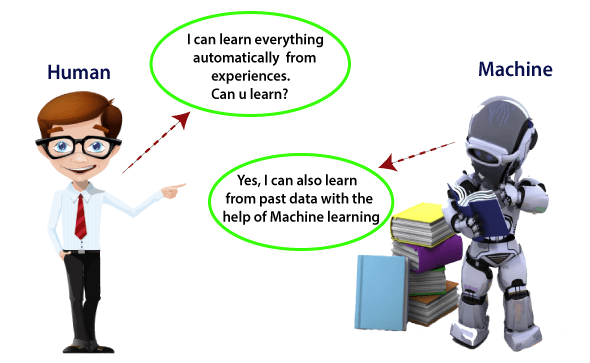
Machine Learning is said as a subset of artificial intelligence that is mainly concerned with the development of algorithms which allow a computer to learn from the data and past experiences on their own. The term machine learning was first introduced by Arthur Samuel in 1959. We can define it in a summarized way as:
Machine learning enables a machine to automatically learn from data, improve performance from experiences, and predict things without being explicitly programmed.
With the help of sample historical data, which is known as training data, machine learning algorithms build a mathematical model that helps in making predictions or decisions without being explicitly programmed. Machine learning brings computer science and statistics together for creating predictive models. Machine learning constructs or uses the algorithms that learn from historical data. The more we will provide the information, the higher will be the performance.
A machine has the ability to learn if it can improve its performance by gaining more data.
How does Machine Learning work
A Machine Learning system learns from historical data, builds the prediction models, and whenever it receives new data, predicts the output for it. The accuracy of predicted output depends upon the amount of data, as the huge amount of data helps to build a better model which predicts the output more accurately.
Suppose we have a complex problem, where we need to perform some predictions, so instead of writing a code for it, we just need to feed the data to generic algorithms, and with the help of these algorithms, machine builds the logic as per the data and predict the output. Machine learning has changed our way of thinking about the problem. The below block diagram explains the working of Machine Learning algorithm:

Features of Machine Learning:
- Machine learning uses data to detect various patterns in a given dataset.
- It can learn from past data and improve automatically.
- It is a data-driven technology.
- Machine learning is much similar to data mining as it also deals with the huge amount of the data.
Need for Machine Learning
The need for machine learning is increasing day by day. The reason behind the need for machine learning is that it is capable of doing tasks that are too complex for a person to implement directly. As a human, we have some limitations as we cannot access the huge amount of data manually, so for this, we need some computer systems and here comes the machine learning to make things easy for us.
We can train machine learning algorithms by providing them the huge amount of data and let them explore the data, construct the models, and predict the required output automatically. The performance of the machine learning algorithm depends on the amount of data, and it can be determined by the cost function. With the help of machine learning, we can save both time and money.
The importance of machine learning can be easily understood by its uses cases, Currently, machine learning is used in self-driving cars, cyber fraud detection, face recognition, and friend suggestion by Facebook, etc. Various top companies such as Netflix and Amazon have build machine learning models that are using a vast amount of data to analyze the user interest and recommend product accordingly.
Following are some key points which show the importance of Machine Learning:
- Rapid increment in the production of data
- Solving complex problems, which are difficult for a human
- Decision making in various sector including finance
- Finding hidden patterns and extracting useful information from data.
Classification of Machine Learning
At a broad level, machine learning can be classified into three types:
- Supervised learning
- Unsupervised learning
- Reinforcement learning
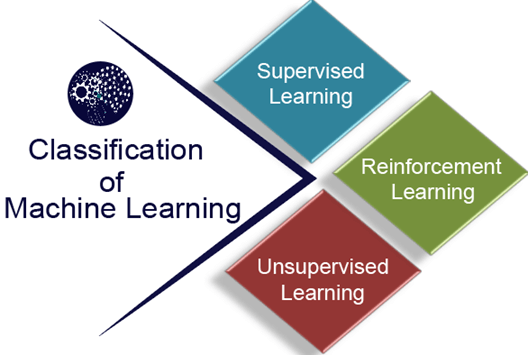
1) Supervised Learning
Supervised learning is a type of machine learning method in which we provide sample labeled data to the machine learning system in order to train it, and on that basis, it predicts the output.
The system creates a model using labeled data to understand the datasets and learn about each data, once the training and processing are done then we test the model by providing a sample data to check whether it is predicting the exact output or not.
The goal of supervised learning is to map input data with the output data. The supervised learning is based on supervision, and it is the same as when a student learns things in the supervision of the teacher. The example of supervised learning is spam filtering.
Supervised learning can be grouped further in two categories of algorithms:
- Classification
- Regression
2) Unsupervised Learning
Unsupervised learning is a learning method in which a machine learns without any supervision.
The training is provided to the machine with the set of data that has not been labeled, classified, or categorized, and the algorithm needs to act on that data without any supervision. The goal of unsupervised learning is to restructure the input data into new features or a group of objects with similar patterns.
In unsupervised learning, we don't have a predetermined result. The machine tries to find useful insights from the huge amount of data. It can be further classifieds into two categories of algorithms:
- Clustering
- Association
3) Reinforcement Learning
Reinforcement learning is a feedback-based learning method, in which a learning agent gets a reward for each right action and gets a penalty for each wrong action. The agent learns automatically with these feedbacks and improves its performance. In reinforcement learning, the agent interacts with the environment and explores it. The goal of an agent is to get the most reward points, and hence, it improves its performance.
The robotic dog, which automatically learns the movement of his arms, is an example of Reinforcement learning.
Note: We will learn about the above types of machine learning in detail in later chapters.
History of Machine Learning
Before some years (about 40-50 years), machine learning was science fiction, but today it is the part of our daily life. Machine learning is making our day to day life easy from self-driving cars to Amazon virtual assistant "Alexa". However, the idea behind machine learning is so old and has a long history. Below some milestones are given which have occurred in the history of machine learning:
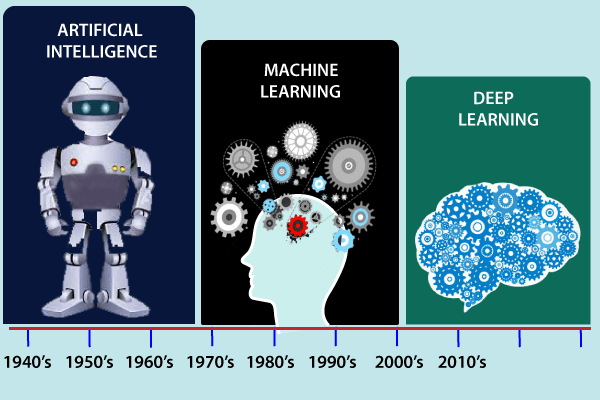
The early history of Machine Learning (Pre-1940):
- 1834: In 1834, Charles Babbage, the father of the computer, conceived a device that could be programmed with punch cards. However, the machine was never built, but all modern computers rely on its logical structure.
- 1936: In 1936, Alan Turing gave a theory that how a machine can determine and execute a set of instructions.
The era of stored program computers:
- 1940: In 1940, the first manually operated computer, "ENIAC" was invented, which was the first electronic general-purpose computer. After that stored program computer such as EDSAC in 1949 and EDVAC in 1951 were invented.
- 1943: In 1943, a human neural network was modeled with an electrical circuit. In 1950, the scientists started applying their idea to work and analyzed how human neurons might work.
Computer machinery and intelligence:
- 1950: In 1950, Alan Turing published a seminal paper, "Computer Machinery and Intelligence," on the topic of artificial intelligence. In his paper, he asked, "Can machines think?"
Machine intelligence in Games:
- 1952: Arthur Samuel, who was the pioneer of machine learning, created a program that helped an IBM computer to play a checkers game. It performed better more it played.
- 1959: In 1959, the term "Machine Learning" was first coined by Arthur Samuel.
The first "AI" winter:
- The duration of 1974 to 1980 was the tough time for AI and ML researchers, and this duration was called as AI winter.
- In this duration, failure of machine translation occurred, and people had reduced their interest from AI, which led to reduced funding by the government to the researches.
Machine Learning from theory to reality
- 1959: In 1959, the first neural network was applied to a real-world problem to remove echoes over phone lines using an adaptive filter.
- 1985: In 1985, Terry Sejnowski and Charles Rosenberg invented a neural network NETtalk, which was able to teach itself how to correctly pronounce 20,000 words in one week.
- 1997: The IBM's Deep blue intelligent computer won the chess game against the chess expert Garry Kasparov, and it became the first computer which had beaten a human chess expert.
Machine Learning at 21st century
- 2006: In the year 2006, computer scientist Geoffrey Hinton has given a new name to neural net research as "deep learning," and nowadays, it has become one of the most trending technologies.
- 2012: In 2012, Google created a deep neural network which learned to recognize the image of humans and cats in YouTube videos.
- 2014: In 2014, the Chabot "Eugen Goostman" cleared the Turing Test. It was the first Chabot who convinced the 33% of human judges that it was not a machine.
- 2014: DeepFace was a deep neural network created by Facebook, and they claimed that it could recognize a person with the same precision as a human can do.
- 2016: AlphaGo beat the world's number second player Lee sedol at Go game. In 2017 it beat the number one player of this game Ke Jie.
- 2017: In 2017, the Alphabet's Jigsaw team built an intelligent system that was able to learn the online trolling. It used to read millions of comments of different websites to learn to stop online trolling.
Machine Learning at present:
Now machine learning has got a great advancement in its research, and it is present everywhere around us, such as self-driving cars, Amazon Alexa, Catboats, recommender system, and many more. It includes Supervised, unsupervised, and reinforcement learning with clustering, classification, decision tree, SVM algorithms, etc.
Modern machine learning models can be used for making various predictions, including weather prediction, disease prediction, stock market analysis, etc.
Applications of Machine learning
Machine learning is a buzzword for today's technology, and it is growing very rapidly day by day. We are using machine learning in our daily life even without knowing it such as Google Maps, Google assistant, Alexa, etc. Below are some most trending real-world applications of Machine Learning:
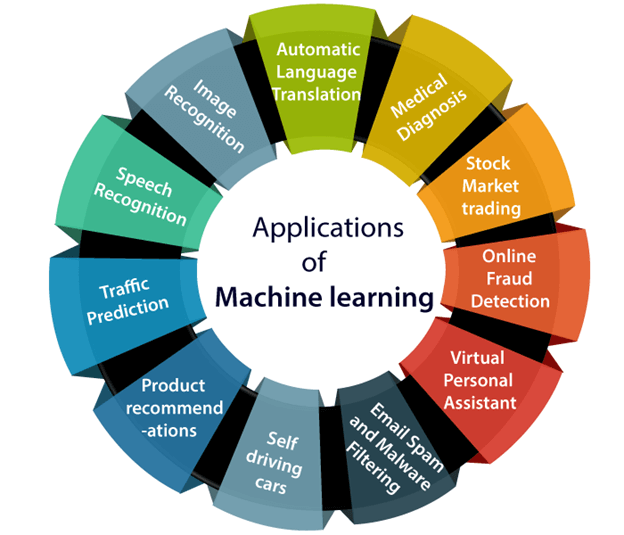
1. Image Recognition:
Image recognition is one of the most common applications of machine learning. It is used to identify objects, persons, places, digital images, etc. The popular use case of image recognition and face detection is, Automatic friend tagging suggestion:
Facebook provides us a feature of auto friend tagging suggestion. Whenever we upload a photo with our Facebook friends, then we automatically get a tagging suggestion with name, and the technology behind this is machine learning's face detection and recognition algorithm.
It is based on the Facebook project named "Deep Face," which is responsible for face recognition and person identification in the picture.
2. Speech Recognition
While using Google, we get an option of "Search by voice," it comes under speech recognition, and it's a popular application of machine learning.
Speech recognition is a process of converting voice instructions into text, and it is also known as "Speech to text", or "Computer speech recognition." At present, machine learning algorithms are widely used by various applications of speech recognition. Google assistant, Siri, Cortana, and Alexa are using speech recognition technology to follow the voice instructions.
3. Traffic prediction:
If we want to visit a new place, we take help of Google Maps, which shows us the correct path with the shortest route and predicts the traffic conditions.
It predicts the traffic conditions such as whether traffic is cleared, slow-moving, or heavily congested with the help of two ways:
- Real Time location of the vehicle form Google Map app and sensors
- Average time has taken on past days at the same time.
Everyone who is using Google Map is helping this app to make it better. It takes information from the user and sends back to its database to improve the performance.
4. Product recommendations:
Machine learning is widely used by various e-commerce and entertainment companies such as Amazon, Netflix, etc., for product recommendation to the user. Whenever we search for some product on Amazon, then we started getting an advertisement for the same product while internet surfing on the same browser and this is because of machine learning.
Google understands the user interest using various machine learning algorithms and suggests the product as per customer interest.
As similar, when we use Netflix, we find some recommendations for entertainment series, movies, etc., and this is also done with the help of machine learning.
5. Self-driving cars:
One of the most exciting applications of machine learning is self-driving cars. Machine learning plays a significant role in self-driving cars. Tesla, the most popular car manufacturing company is working on self-driving car. It is using unsupervised learning method to train the car models to detect people and objects while driving.
6. Email Spam and Malware Filtering:
Whenever we receive a new email, it is filtered automatically as important, normal, and spam. We always receive an important mail in our inbox with the important symbol and spam emails in our spam box, and the technology behind this is Machine learning. Below are some spam filters used by Gmail:
- Content Filter
- Header filter
- General blacklists filter
- Rules-based filters
- Permission filters
Some machine learning algorithms such as Multi-Layer Perceptron, Decision tree, and Naïve Bayes classifier are used for email spam filtering and malware detection.
7. Virtual Personal Assistant:
We have various virtual personal assistants such as Google assistant, Alexa, Cortana, Siri. As the name suggests, they help us in finding the information using our voice instruction. These assistants can help us in various ways just by our voice instructions such as Play music, call someone, Open an email, Scheduling an appointment, etc.
These virtual assistants use machine learning algorithms as an important part.
These assistant record our voice instructions, send it over the server on a cloud, and decode it using ML algorithms and act accordingly.
8. Online Fraud Detection:
Machine learning is making our online transaction safe and secure by detecting fraud transaction. Whenever we perform some online transaction, there may be various ways that a fraudulent transaction can take place such as fake accounts, fake ids, and steal money in the middle of a transaction. So to detect this, Feed Forward Neural network helps us by checking whether it is a genuine transaction or a fraud transaction.
For each genuine transaction, the output is converted into some hash values, and these values become the input for the next round. For each genuine transaction, there is a specific pattern which gets change for the fraud transaction hence, it detects it and makes our online transactions more secure.
9. Stock Market trading:
Machine learning is widely used in stock market trading. In the stock market, there is always a risk of up and downs in shares, so for this machine learning's long short term memory neural network is used for the prediction of stock market trends.
10. Medical Diagnosis:
In medical science, machine learning is used for diseases diagnoses. With this, medical technology is growing very fast and able to build 3D models that can predict the exact position of lesions in the brain.
It helps in finding brain tumors and other brain-related diseases easily.11. Automatic Language Translation:
Nowadays, if we visit a new place and we are not aware of the language then it is not a problem at all, as for this also machine learning helps us by converting the text into our known languages. Google's GNMT (Google Neural Machine Translation) provide this feature, which is a Neural Machine Learning that translates the text into our familiar language, and it called as automatic translation.
The technology behind the automatic translation is a sequence to sequence learning algorithm, which is used with image recognition and translates the text from one language to another language.
Machine learning Life cycle
Machine learning has given the computer systems the abilities to automatically learn without being explicitly programmed. But how does a machine learning system work? So, it can be described using the life cycle of machine learning. Machine learning life cycle is a cyclic process to build an efficient machine learning project. The main purpose of the life cycle is to find a solution to the problem or project.
Machine learning life cycle involves seven major steps, which are given below:
- Gathering Data
- Data preparation
- Data Wrangling
- Analyse Data
- Train the model
- Test the model
- Deployment
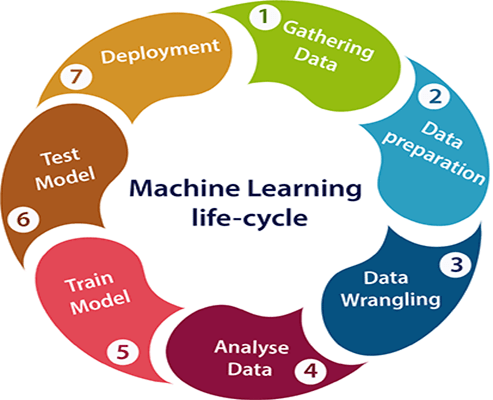
The most important thing in the complete process is to understand the problem and to know the purpose of the problem. Therefore, before starting the life cycle, we need to understand the problem because the good result depends on the better understanding of the problem.
In the complete life cycle process, to solve a problem, we create a machine learning system called "model", and this model is created by providing "training". But to train a model, we need data, hence, life cycle starts by collecting data.
1. Gathering Data:
Data Gathering is the first step of the machine learning life cycle. The goal of this step is to identify and obtain all data-related problems.
In this step, we need to identify the different data sources, as data can be collected from various sources such as files, database, internet, or mobile devices. It is one of the most important steps of the life cycle. The quantity and quality of the collected data will determine the efficiency of the output. The more will be the data, the more accurate will be the prediction.
This step includes the below tasks:
- Identify various data sources
- Collect data
- Integrate the data obtained from different sources
By performing the above task, we get a coherent set of data, also called as a dataset. It will be used in further steps.
2. Data preparation
After collecting the data, we need to prepare it for further steps. Data preparation is a step where we put our data into a suitable place and prepare it to use in our machine learning training.
In this step, first, we put all data together, and then randomize the ordering of data.
This step can be further divided into two processes:
- Data exploration:
It is used to understand the nature of data that we have to work with. We need to understand the characteristics, format, and quality of data.
A better understanding of data leads to an effective outcome. In this, we find Correlations, general trends, and outliers. - Data pre-processing:
Now the next step is preprocessing of data for its analysis.
3. Data Wrangling
Data wrangling is the process of cleaning and converting raw data into a useable format. It is the process of cleaning the data, selecting the variable to use, and transforming the data in a proper format to make it more suitable for analysis in the next step. It is one of the most important steps of the complete process. Cleaning of data is required to address the quality issues.
It is not necessary that data we have collected is always of our use as some of the data may not be useful. In real-world applications, collected data may have various issues, including:
- Missing Values
- Duplicate data
- Invalid data
- Noise
So, we use various filtering techniques to clean the data.
It is mandatory to detect and remove the above issues because it can negatively affect the quality of the outcome.
4. Data Analysis
Now the cleaned and prepared data is passed on to the analysis step. This step involves:
- Selection of analytical techniques
- Building models
- Review the result
The aim of this step is to build a machine learning model to analyze the data using various analytical techniques and review the outcome. It starts with the determination of the type of the problems, where we select the machine learning techniques such as Classification, Regression, Cluster analysis, Association, etc. then build the model using prepared data, and evaluate the model.
Hence, in this step, we take the data and use machine learning algorithms to build the model.
5. Train Model
Now the next step is to train the model, in this step we train our model to improve its performance for better outcome of the problem.
We use datasets to train the model using various machine learning algorithms. Training a model is required so that it can understand the various patterns, rules, and, features.
6. Test Model
Once our machine learning model has been trained on a given dataset, then we test the model. In this step, we check for the accuracy of our model by providing a test dataset to it.
Testing the model determines the percentage accuracy of the model as per the requirement of project or problem.
7. Deployment
The last step of machine learning life cycle is deployment, where we deploy the model in the real-world system.
If the above-prepared model is producing an accurate result as per our requirement with acceptable speed, then we deploy the model in the real system. But before deploying the project, we will check whether it is improving its performance using available data or not. The deployment phase is similar to making the final report for a project.
Great and knowledgeable article, I'm really impressed and thanks for sharing your knowledge with us.
ReplyDeleteTop Consultancy in Delhi for Genuine Experience Certificate
Best Consultancy in Bangalore for Genuine Experience Certificate
Casinos Near Harrah's Casino & Racetrack - Mapyro
ReplyDeleteand 안산 출장안마 many others with excellent service and excellent customer support. 용인 출장안마 Harrah's Gulf Coast Casino & Racetrack - The Official 시흥 출장안마 Guide. 영주 출장마사지 Casino Resort Spa. 강릉 출장마사지 Harrah's Gulf Coast Casino & Racetrack.